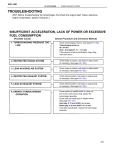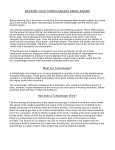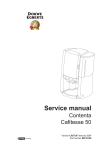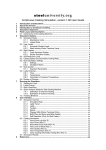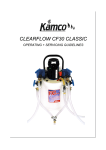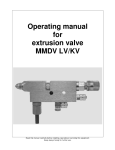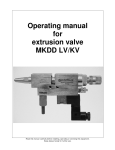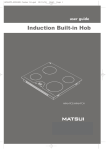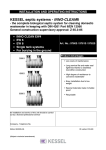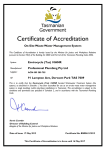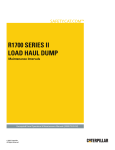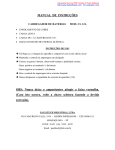Download abnormals engine - Wanderlodge Owners Group
Transcript
Generated by Foxit PDF Creator © Foxit Software
http://www.foxitsoftware.com For evaluation only.
VAGABOND’S HANDBOOK
Abnormal Procedures
03/24/07
ENGINE
Engine RPM fluctuates at Idle (200 rpm +/-)
Caused by a small fuel leak at the Governor shaft seal, allowing to suck air and
leak fuel into the Valley of the Engine. Not a problem unless the engine stalls out when at
idle causing damage to the Turbo spinning without oil lubrication. If this is the case, keep
engine rpm up when stopping coach.
Engine quits Normally caused by no fuel getting to the engine.
Racor Fuel Filter plugged up either in the bowl or internally in dispenser.
Check for a blocked, or broken, or a came apart, fuel line.
Check the suction tube in tank blocked, (very involved).
Could be stuff in the fuel tank, blocking the suction tube/ fuel pick-up.
Engine runs intermittend
Fuel Filters clogged, open and clogging intermittently.
Engine slowly overheats
Check coolant level. If low, find out why (could be between loose screw and
major problem.
Check the belts and pulleys running the fan
Check radiator for being blocked by dirt, leaves, or pests.
Engine will not start
Check rear Start selector switch on FWD
Check if Battery is grounded properly, connections are clean and tight.
Check Battery Voltage.
If electric power is up front, check Starter solenoid, connections, wires
Engine Black Smoke ( Engine needs lots of Air with Fuel)
A blocked Air Filter
Always check Air Filter for cleanliness. (Avoid driving in dust)
Broken Exhaust before Turbo inlet, preventing pumping Air into engine.
Engine looses Power, Coach slows down
Check for dirty Fuel Filter, Primary and secondary.
Loosing speed, Transmission fluid going down, check for leaks
Engine Oil
DISCOLORED QUANTITY INCREASED -
Abnormal Procedures
Bad, water gets in oil (blown head gasket,
cracked head or block
Fuel getting into oil, could be broken fuel
line in crossover line under valve cover.
page 1
Blue-Bird
Generated by Foxit PDF Creator © Foxit Software
http://www.foxitsoftware.com For evaluation only.
VAGABOND’S HANDBOOK
Abnormal Procedures
03/24/07
Common complaints, causes and possible solutions
1. Low Power
CAUSE:
Dirty air cleaner or restricted air inlet.
SOLUTION: Replace air cleaner element and clean air passage.
CAUSE:
Viscosity of oil bath air cleaner too high.
SOLUTION:
Service air cleaner in accordance with engine manufactures service
manual.
CAUSE:
Loose compressor-to-intake manifold duct connections.
SOLUTION: Tighten connections as required.
CAUSE:
Leakage at engine intake manifold.
SOLUTION: Refer to engine engine manufacturers service manual.
CAUSE:
Leakage at engine exhaust manifold.
SOLUTION: Refer to engine engine manufacturers service manual.
CAUSE:
Leakage at Turbocharger mounting flange.
SOLUTION: Check condition of gasket at turbocharger mounting flange and tighten
loose bolts (Note: gasket is not used in all applications).
CAUSE:
Restricted duct between the air cleaner and turbocharger compressor.
SOLUTION: Remove restriction or replace damaged parts as necessary.
CAUSE:
Restricted duct between compressor and engine intake manifold.
SOLUTION: Remove restriction or replace damaged parts as necessary.
CAUSE:
Restricted Engine Exhaust system (After Turbocharger)
SOLUTION: Remove restriction or replace damaged parts as necessary.
CAUSE:
Restricted Engine Intake or Exhaust manifold.
SOLUTION: Refer to engine engine manufacturers service manual.
CAUSE:
Engine Malfunction (Fuel System component, valves, valve timing, rings,
pistons, etc.
SOLUTION: Refer to engine engine manufacturers service manual.
2. White or Blue Smoke
CAUSE:
Dirty air cleaner or restricted air inlet
SOLUTION: Replace air cleaner element and clean air passage.
CAUSE:
iscosity of oil bath air cleaner too high.
SOLUTION: Service air cleaner in accordance with engine manufactures service
manual.
CAUSE:
Plugged engine oil filter.
SOLUTION: Service oil filter in accordance with engine manufacturers service manual.
CAUSE:
Restricted duct between the air cleaner and turbocharger compressor.
SOLUTION: Remove restriction or replace damaged parts as necessary.
CAUSE:
Seal leakage at compressor end of turbocharger.
SOLUTION: See #6 problem below.
CAUSE:
Engine Malfunction (rings, pistons, valves, etc.)
SOLUTION: Refer to the engine manufacturers service manual.
CAUSE:
Seal leakage at turbine end of turbocharger.
SOLUTION: See #7 problem below.
Abnormal Procedures
page 2
Blue-Bird
Generated by Foxit PDF Creator © Foxit Software
http://www.foxitsoftware.com For evaluation only.
VAGABOND’S HANDBOOK
Abnormal Procedures
03/24/07
3. Engine oil consumption excessive
CAUSE:
Wrong type or viscosity of engine lubricating oil.
SOLUTION: Service engine lube system in accordance with engine manufacturers
service manual.
CAUSE:
Seal leakage at compressor end of turbocharger (indicated by oil in
housing or on wheel).
SOLUTION: See #6 problem below.
CAUSE:
Seal leakage at turbine end of turbocharger (indicated by oil in housing or
on wheel).
SOLUTION: See #7 problem below.
CAUSE:
Oil in engine exhaust manifold (indicating malfunction of rings, pistons,
valves, etc.)
SOLUTION: Refer to engine manufacturers service manual.
4. Noisy Turbocharger
CAUSE:
Dirty air cleaner or restricted air inlet.
SOLUTION: Replace air cleaner or remove or replace restriction.
CAUSE:
Foreign object or material in compressor inlet ducting or compressor
housing.
SOLUTION: emove foreign object. Repair air intake system and replace turbocharger if
necessary.
CAUSE:
Foreign object or material in compressor-to-intake manifold ducting.
SOLUTION: Remove foreign object. Repair air intake system and replace turbocharger
if necessary.
CAUSE:
Foreign object in engine exhaust system.
SOLUTION: Remove foreign object. Repair exhaust system and replace turbocharger if
necessary.
CAUSE:
Carbon build up in turbine housing.
SOLUTION: Clean housing or replace turbocharger - check engine operating
procedures.
CAUSE:
Turbocharger rotating assembly binding or dragging.
SOLUTION: See #5 below.
CAUSE:
Loose intake or exhaust ducting systems
SOLUTION: Eliminate all leaks.
5. Turbocharger rotating assembly binding or dragging
CAUSE:
Damaged compressor wheel due to foreign object impact.
SOLUTION: Clean and repair air intake system as necessary. Replace Turbocharger.
CAUSE:
Damaged turbine wheel due to foreign object impact.
SOLUTION: Clean and repair engine exhaust system as necessary. Replace
Turbocharger.
CAUSE:
Compressor wheel or turbine wheel rubbing on housing.
SOLUTION: Worn bearings, shaft journals or bearing bores. Replace Turbocharger.
CAUSE:
Excessive dirt build-up in compressor (on housing or wheel)
Abnormal Procedures
page 3
Blue-Bird
Generated by Foxit PDF Creator © Foxit Software
http://www.foxitsoftware.com For evaluation only.
VAGABOND’S HANDBOOK
Abnormal Procedures
03/24/07
SOLUTION: Clean and repair air intake system as necessary. Clean compressor or
replace Turbocharger.
CAUSE:
Excessive carbon build-up behind turbine wheel.
SOLUTION: Coked Oil or Combustion Deposits. Replace Turbocharger.
CAUSE:
Sludged or coked center housing.
SOLUTION: Service engine lubrication system. Replace Turbocharger.
6. Oil seal leakage at compressor end of turbocharger
CAUSE:
Dirty air cleaner or restricted air inlet.
SOLUTION: Change air filter or remove or replace restriction.
CAUSE:
Viscosity of oil in oil bath air cleaner too high.
SOLUTION: Service air cleaner in accordance with engine manufacturers service
manual.
CAUSE:
Restricted turbocharger oil drain line.
SOLUTION: Clean and remove restriction or replace oil drain line as required.
CAUSE:
Plugged engine crankcase breather.
SOLUTION: Refer to engine manufacturers service manual.
CAUSE:
Worn or damaged compressor wheel.
SOLUTION: Clean and repair air intake system as necessary. Replace Turbocharger.
CAUSE:
Turbocharger bearings, bearing bores or shaft journal worn.
SOLUTION: Replace Turbocharger.
CAUSE:
Engine malfunction (excessive piston blowby or high internal crankcase
pressure).
SOLUTION: Refer to engine manufacturers service manual.
CAUSE:
Over-full crankcase.
SOLUTION: Adjust oil level in crankcase to proper level.
7. Oil seal leakage at turbine end of the turbocharger
CAUSE:
Excessive pre-oiling.
SOLUTION: Oil will burn away no action required.
CAUSE:
Plugged engine crankcase breather.
SOLUTION: Refer to engine manufacturers service manual.
CAUSE:
Restricted turbocharger oil drain lines.
SOLUTION: Clean and remove restriction or replace oil drain line as required.
CAUSE:
Sludged or coked center housing.
SOLUTION: Service engine lubrication system. Replace Turbocharger.
CAUSE:
Turbocharger bearings, bearing bores or shaft journals worn.
SOLUTION: Replace Turbocharger.
CAUSE:
Engine malfunction (excessive piston blow-by or high internal crankcase
pressure).
SOLUTION: Refer to engine manufacturers service manual.
CAUSE: Over-full crankcase.
SOLUTION: Adjust oil level in crankcase to proper level.
Abnormal Procedures
page 4
Blue-Bird
Generated by Foxit PDF Creator © Foxit Software
http://www.foxitsoftware.com For evaluation only.
VAGABOND’S HANDBOOK
Abnormal Procedures
03/24/07
CRUISE CONTROL ACTS ERRATIC
Surges and sloppy operation could be caused by the dip switches located inside
the 6 X 6 in module. Switches might have vibrated loose or set wrong due to excessive
vibration.
Abnormal Procedures
page 5
Blue-Bird
Generated by Foxit PDF Creator © Foxit Software
http://www.foxitsoftware.com For evaluation only.
VAGABOND’S HANDBOOK
Abnormal Procedures
03/24/07
Loss of Coolant
Recommended Procedure
A. Outside Leaks
1. Leaks in Hoses or Connections. . . Check all hoses and connections for visual signs of
leakage. If no leaks are seen, look for damage to hoses or loose clamps.
2. Leaks in the Radiator and/or Expansion Tank. . . Put pressure to the radiator and/or
expansion tank with the 9S8140 Cooling System Pressurizing Pump Group and check for
leaks.
3. Leaks in the Heater. . . Put pressure to the cooling system with the 9S8140 Cooling
System pressurizing Pump Group and check the heater for leaks.
4. Leaks in the Water Pump. . . Check the water pump for leaks before starting the
engine. then start the engine and look for leaks. If there are leaks at the water pump,
repair or install a new water pump.
5. Cylinder Head Gasket Leakage. . . Look for leaks along the surface of the cylinder
head gasket. If you see leaks. install a new head gasket.
B. Coolant Leaks at the Overflow Tube
6. Bad Pressure Cap or Relief Valve. . . Check the sealing surfaces of the pressure cap
and the radiator to be sure the cap is sealing correctly. Check the opening pressure and
sealing ability of the pressure cap or relief valve with the 9S8140 Cooling
5ystemPressurizing Pump Group.
7. Engine Runs Too Hot. . . If coolant temperature is too high. pressure will be high
enough to move the cap off of the sealing surface in the radiator and cause coolant loss
through the overflow tube. See "Above Normal Heating" in COOLING SYSTEM Chart.
8. Expansion Tank Too Small or Installed Wrong. . . The expansion tank can be either a
part of the radiator or it can be installed separately from the radiator. The expansion tank
must be large enough to hold the expansion of the coolant as it gets warm or has sudden
changes in pressure. Make sure the expansion tank is installed correctly. and the size is
according to the recommendations of the Truck Manufacturer.
9. Cylinder Head Gasket Leakage, or Crack(s) in Cylinder Head or Cylinder Block. . .
Remove the radiator cap and with the engine running look for air bubbles in the coolant.
Bubbles in the coolant are a sign of probable leakage at the head gasket. With the engine
not running. check each cylinder with the cylinder leakage tester. Special Instruction,
Form No. GMGOO694 gives the test procedure. If you see air bubbles in the coolant
during this test, there is a leak of combustion gas into the cooling system. Remove the
cylinder heads from the engine. Check cylinder heads, cylinder walls and head gasket
surface of the cylinder block for cracks. When installing heads. use new head gasket.
Abnormal Procedures
page 6
Blue-Bird
Generated by Foxit PDF Creator © Foxit Software
http://www.foxitsoftware.com For evaluation only.
VAGABOND’S HANDBOOK
Abnormal Procedures
03/24/07
C. Inside Leakage
10. Cylinder Head Gasket Leakage. . . If the cylinder head gasket leaks between a water
passage and an opening into the crankcase, coolant will get into the crankcase.
11. Crack(s) in Cylinder Head. . . Crack(s) in the upper surface of the cylinder head. or an
area between a water passage and an opening into the crankcase. can allow coolant to get
into the crankcase.
12. Crack(s) in Cylinder Block. . . Crack{s) in the cylinder block between a water
passage and the crankcase will let coolant get into the crankcase.
Abnormal Procedures
page 7
Blue-Bird
Generated by Foxit PDF Creator © Foxit Software
http://www.foxitsoftware.com For evaluation only.
VAGABOND’S HANDBOOK
Abnormal Procedures
03/24/07
Cooling System
Above Normal Heating
Recommended Procedure
1. Low Coolant Level. . .If the coolant level is too low, not enough coolant will go
through the engine and radiator. This lack of coolant will not take enough heat from the
engine and there will not be enough flow of coolant through the radiator to release the
heat into the cooling air. Low coolant level is caused by leaks or wrong filling of the
radiator. With the engine cool, be sure that coolant can be seen at the low end of the fill
neck on the radiator top tank.
2. Bad Temperature Gauge. . . A temperature gauge which does not work correctly will
not show the correct temperature. If the temperature gauge shows that the coolant
temperature is too hot but other conditions are normal, either install a gauge you know is
good or check the cooling system with the 8T0470 Thermistor Thermometer Group.
3. Dirty Radiator. . . Check the radiator for debris between the fins of the radiator core
which prevents free air flow through the radiator core. Check the radiator for debris, dirt,
or deposits on the inside of the radiator core which prevents free flow of coolant through
the radiator.
4. Loose Belt(s) . . . Loose fan belts will cause a reduction in air flow. Tighten the belts
according to V-Belt Tension Chart that is shown in Specification section of this Service
Manual.
5. Bad Hose(s) . . . Bad hoses with leaks can normally be seen. Hoses that have no visual
leaks can 'collapse" (pull together) during operation and cause a restriction in the flow of
coolant. Hoses become soft and/or get cracks after a period of time. Hoses must be
changed after 50,000 miles or a year of use. The inside of a hose can deterioriate. and the
.ioose particles of the hose can cause a restriction in the flow of coolant.
6. Shunt Line Restriction. . . A restriction of the shunt line from the radiator top tank to
the engine water pump inlet, or a shunt line not installed correctly, will cause a reduction
in water pump efficiency. The result will be low coolant flow and overheating.
7. Shutters Not Opening Correctly. . . Check the opening temperature of the shutters. The
shutters must be completely closed at a temperature below the fully open temperature of
the water temperature regulators.
8. Bad Water Temperature Regulator(s} . . . A regulator that does not open, or only opens
part of the way. Can cause above normal heating. To test the thermostats. see the Testing
and Adjusting section of this Service Manual.
Abnormal Procedures
page 8
Blue-Bird
Generated by Foxit PDF Creator © Foxit Software
http://www.foxitsoftware.com For evaluation only.
VAGABOND’S HANDBOOK
Abnormal Procedures
03/24/07
9. Bad Water Pump. . . A water pump with a loose or damaged impeller does not pump
enough coolant for correct engine cooling. Remove the water pump and check for
damage to the impeller. If the impeller has no damage. check the impeller clearance. The
clearance between the impeller and the housing is 0.28 to 0.84 mm (.011 to .033 in).
10. Air in Cooling System. . . Air can get into the cooling system in different ways. The
most common causes are not filling the cooling system correctly, and combustion gas
leaking into the system. Combustion gas can get into the system. through inside cracks or
bad cylinder head gaskets. Air in the cooling system causes a reduction in coolant flow
and bubbles in the coolant. Air bubbles hold coolant away from engine parts, preventing
heat flow. Air in the cooling system can be found by the Bottle Test. The equipment
needed to make this test is a one pint bottle, a bucket of water and a hose which will fit
the end of the overflow pipe of the radiator. Before testing, make sure the cooling system
is filled correctly. Use a wire to hold the relief valve in the radiator cap open. Install the
radiator cap and tighten it. Put the hose over the end of the overflow pipe.
Start the engine and operate it at high idle rpm for a minimum of five minutes
after the engine is at normal operating temperature. Use a cover on the radiator core to
keep the engine at operating temperature. After five or more minutes at operating
temperature. place the loose end of the hose in the bottle filled with water. Put the bottle
in the bucket of water with the top down. If the water gets out of the bottle in less than
forty seconds, there is too much exhaust gas leakage into the cooling system. Find the
cause of the air or gas getting into the cooling system and correct as necessary.
Abnormal Procedures
page 9
Blue-Bird
Generated by Foxit PDF Creator © Foxit Software
http://www.foxitsoftware.com For evaluation only.
VAGABOND’S HANDBOOK
Abnormal Procedures
Abnormal Procedures
03/24/07
page 10
Blue-Bird










